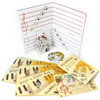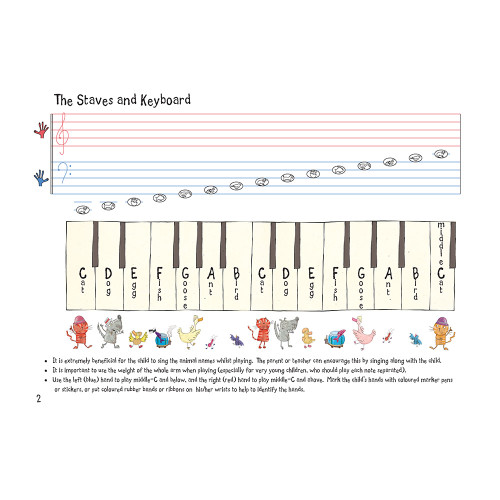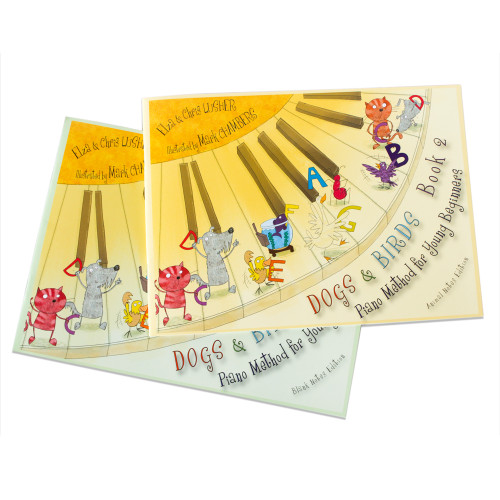XMAS OFFER: GET AN ADDITIONAL 9% DISCOUNT ON THIS BUNDLE
Dogs and Birds is a multisensory approach with many musical activities. The beginners’ set is a package which is perfect for starting your child’s musical journey. It includes:
- Two beautifully coloured Book 1s (one with animal symbols and one without), which teach your child to read, sing and play musical notation. They also establish hand co-ordination and rhythm.
- Coloured Staves and the 56 Small Animal Tiles, which are excellent support for ear training, finger exercises, compositions, and making reading music simple.
- Notes and Lesson Plans to Book 1 for Parents and Teachers, which gives you our 17 recommended steps for covering the material in Book 1, and the Music Manuscript Book, which helps you to be well organized.
It just makes learning so effortless and so much fun. Vici Hoban Read, Jiggle and Jam
It is a real treat to discover a new and imaginative approach to teaching the piano which really works. Faye Cayley, Music Teacher Magazine
- Paperback:
- 184 pages (50 pages each tutor book, 84 Pages Notes and Lesson Plans)
- Accessories:
- Small Animal Tiles, Coloured Staves, Music Manuscript Book (4 Staves per Page)
- Composer:
- Elza and Chris Lusher
- Illustrator:
- Mark Chambers
- Publisher:
- Dogs and Birds
- ISBN-10:
- 1-4706-1182-1
- ISBN-13:
- 978-1-4706-1182-8
21 Reviews
-
Lovely materials for Kodaly-trained pupils
I'm a piano teacher but also teach early years Kodaly and these materials are ideal for my pupils, who have mostly done 2-3 years of Kodaly before starting piano. This method has obviously been very thoroughly thought-through and is a joy to use. The illustrations and the stories in the Pupil books are delightful and really engage young children's imaginations. Really nicely put together. It's great to have the two books identical save for the animal notation as it gives children bags of confidence! The Teachers book is a useful resource some great ideas for additional exercises and games and really enrich the use of the Pupil books. The tiles are helpful and its nice to have each one slightly different - just as every D sounds slightly different, each dog is an individual too! Placing the tiles on the keys is a great way to find the notes but not practical for playing (they slip around too much), so we tend to prop them perpendicular to the key (slipped behind the black notes). The stave is nice to have and it's great that you can use the tiles straight from the piano onto the stave. It would have been even better to have them made to stick on the stave (velcro? magnets?) rather than fiddling with blu-tack though. My only other comment would be that, as this is a Kodaly-based technique, it would be nice to see the sol-fa (solfege) names used as well as the Dog & Bird, which would help with the cross-over for pupils who've already had Kodaly training. The only other Kodaly-based piano book I have previously used the Colourstrings Piano ABC book but Dogs & Birds is far superior - it's far more engaging and (also important) much more reasonably priced!
-
A great way to introduced a young child to music in a systematic, but playful way!
My 4-year-old son and I are enjoying the materials enormously. With all the different types of exercises it is no problem to keep him interested. He loves discovering new animals and finding out what they get up to in the stories. They really fuel his imagination, which makes it very easy to let him discover all the different parts and aspects of the piano in a systematic, but playful way. Thanks a lot for creating this method!
-
Review of using the 'Dogs and Birds' method with young kids.
It seems quite the thing these days to start young children on the piano with various figurines representing the notes or dancing round the classroom pretending to be an elephant just to get the pupils to pay attention, and I'll admit I've not been a fan of a lot of such methods. However I've now started with a handful of pupils from their first ever lesson with this method and it has been superb. The parents are blown away by their children's ability to pick things up so quickly, and so far I've not had much of a problem leaving the tiles behind and going onto proper notation. So my review - if you're a teacher about who's about to take on pupils from scratch, there's no better method on the market.





























